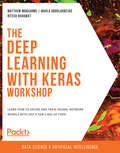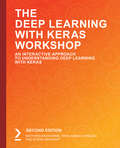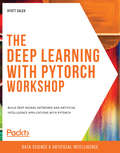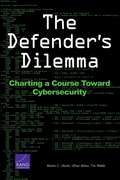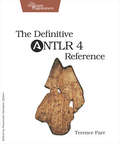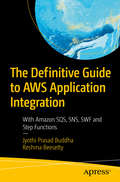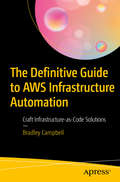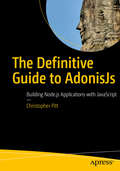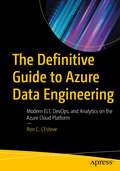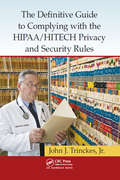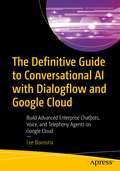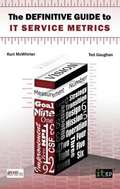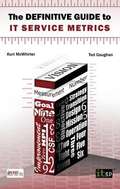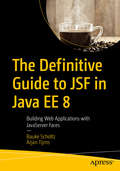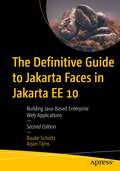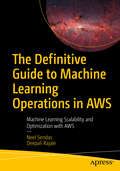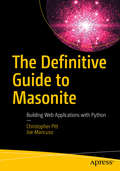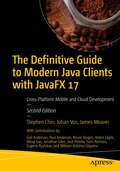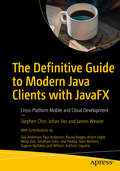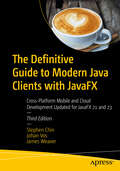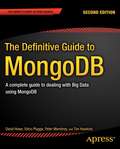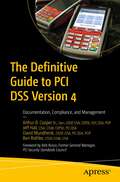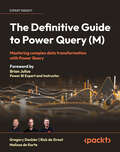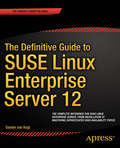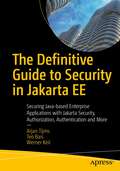- Table View
- List View
The Deep Learning with Keras Workshop - Third Edition: Solve Complex Real-life Problems With The Simplicity Of Keras
by Mahla Abdolahnejad Matthew MoocarmeIf you know the basics of data science and machine learning, and want to get started with advanced machine learning technologies, such as artificial neural networks and deep learning, this workshop makes it easy. To grasp the concepts explained in this deep learning book more effectively, prior experience in Python programming and some familiarity with statistics and logistic regression are a must.
The Deep Learning with Keras Workshop: An Interactive Approach to Understanding Deep Learning with Keras, 2nd Edition
by Ritesh Bhagwat Mahla Abdolahnejad Matthew MoocarmeCut through the noise and get real results with a step-by-step approach to understanding deep learning with Keras programming Key Features Ideal for those getting started with Keras for the first time A step-by-step Keras tutorial with exercises and activities that help build key skills Structured to let you progress at your own pace, on your own terms Use your physical print copy to redeem free access to the online interactive edition Book Description You already know that you want to learn Keras, and a smarter way to learn is to learn by doing. The Deep Learning with Keras Workshop focuses on building up your practical skills so that you can develop artificial intelligence applications or build machine learning models with Keras. You'll learn from real examples that lead to real results. Throughout The Deep Learning with Keras Workshop, you'll take an engaging step-by-step approach to understand Keras. You won't have to sit through any unnecessary theory. If you're short on time you can jump into a single exercise each day or spend an entire weekend tinkering with your own neural networks. It's your choice. Learning on your terms, you'll build up and reinforce key skills in a way that feels rewarding. Every physical print copy of The Deep Learning with Keras Workshop unlocks access to the interactive edition. With videos detailing all exercises and activities, you'll always have a guided solution. You can also benchmark yourself against assessments, track progress, and receive content updates. You'll even earn a secure credential that you can share and verify online upon completion. It's a premium learning experience that's included with your printed copy. To redeem, follow the instructions located at the start of your book. Fast-paced and direct, The Deep Learning with Keras Workshop is the ideal companion for those who are just getting started with Keras. You'll build and iterate on your code like a software developer, learning along the way. This process means that you'll find that your new skills stick, embedded as best practice. A solid foundation for the years ahead. What you will learn Gain insight into the fundamental concepts of neural networks Learn to think like a data scientist and understand the difference between machine learning and deep learning Discover various techniques to evaluate, tweak, and improve your models Explore different techniques to manipulate your data Explore alternative techniques to verify the accuracy of your model Who this book is for Our goal at Packt is to help you be successful, in whatever it is that you choose to do. The Deep Learning with Keras Workshop is an ideal tutorial for the programmer who is getting started with Keras and deep learning. Pick up a Workshop today and let Packt help you develop skills that stick with you for life.
The Deep Learning with PyTorch Workshop: Build deep neural networks and artificial intelligence applications with PyTorch
by Hyatt SalehGet a head start in the world of AI and deep learning by developing your skills with PyTorch Key Features Learn how to define your own network architecture in deep learning Implement helpful methods to create and train a model using PyTorch syntax Discover how intelligent applications using features like image recognition and speech recognition really process your data Book Description Want to get to grips with one of the most popular machine learning libraries for deep learning? The Deep Learning with PyTorch Workshop will help you do just that, jumpstarting your knowledge of using PyTorch for deep learning even if you're starting from scratch. It's no surprise that deep learning's popularity has risen steeply in the past few years, thanks to intelligent applications such as self-driving vehicles, chatbots, and voice-activated assistants that are making our lives easier. This book will take you inside the world of deep learning, where you'll use PyTorch to understand the complexity of neural network architectures. The Deep Learning with PyTorch Workshop starts with an introduction to deep learning and its applications. You'll explore the syntax of PyTorch and learn how to define a network architecture and train a model. Next, you'll learn about three main neural network architectures - convolutional, artificial, and recurrent - and even solve real-world data problems using these networks. Later chapters will show you how to create a style transfer model to develop a new image from two images, before finally taking you through how RNNs store memory to solve key data issues. By the end of this book, you'll have mastered the essential concepts, tools, and libraries of PyTorch to develop your own deep neural networks and intelligent apps. What you will learn Explore the different applications of deep learning Understand the PyTorch approach to building neural networks Create and train your very own perceptron using PyTorch Solve regression problems using artificial neural networks (ANNs) Handle computer vision problems with convolutional neural networks (CNNs) Perform language translation tasks using recurrent neural networks (RNNs) Who this book is for This deep learning book is ideal for anyone who wants to create and train deep learning models using PyTorch. A solid understanding of the Python programming language and its packages will help you grasp the topics covered in the book more quickly.
The Defender's Dilemma: Charting a Course Toward Cybersecurity
by Martin C. Libicki Lillian Ablon Tim WebbCybersecurity is a constant, and, by all accounts growing, challenge. This report, the second in a multiphase study on the future of cybersecurity, reveals perspectives and perceptions from chief information security officers; examines the development of network defense measures and the countermeasures that attackers create to subvert those measures; and explores the role of software vulnerabilities and inherent weaknesses. "
The Definitive ANTLR 4 Reference (Oreilly And Associate Ser.)
by Terence ParrProgrammers run into parsing problems all the time. Whether it's a data format like JSON, a network protocol like SMTP, a server configuration file for Apache, a PostScript/PDF file, or a simple spreadsheet macro language--ANTLR v4 and this book will demystify the process. ANTLR v4 has been rewritten from scratch to make it easier than ever to build parsers and the language applications built on top. This completely rewritten new edition of the bestselling Definitive ANTLR Reference shows you how to take advantage of these new features.Build your own languages with ANTLR v4, using ANTLR's new advanced parsing technology. In this book, you'll learn how ANTLR automatically builds a data structure representing the input (parse tree) and generates code that can walk the tree (visitor). You can use that combination to implement data readers, language interpreters, and translators. You'll start by learning how to identify grammar patterns in language reference manuals and then slowly start building increasingly complex grammars. Next, you'll build applications based upon those grammars by walking the automatically generated parse trees. Then you'll tackle some nasty language problems by parsing files containing more than one language (such as XML, Java, and Javadoc). You'll also see how to take absolute control over parsing by embedding Java actions into the grammar. You'll learn directly from well-known parsing expert Terence Parr, the ANTLR creator and project lead. You'll master ANTLR grammar construction and learn how to build language tools using the built-in parse tree visitor mechanism. The book teaches using real-world examples and shows you how to use ANTLR to build such things as a data file reader, a JSON to XML translator, an R parser, and a Java class->interface extractor. This book is your ticket to becoming a parsing guru!What You Need:ANTLR 4.0 and above. Java development tools. Ant build system optional(needed for building ANTLR from source)
The Definitive Guide to AWS Application Integration: With Amazon SQS, SNS, SWF and Step Functions
by Jyothi Prasad Buddha Reshma BeesettyBuild reliable, asynchronous, and distributed applications using message queuing and task orchestration capabilities of Amazon Web Services (AWS) Application Integration. This book prepares you to build distributed applications and administrators, and manage queues, workflows, and state machines.You'll start by reviewing key AWS prerequisite services such as EC2, Lambda, S3, DynamoDB, CloudWatch, and IAM. Simple Queue Service (SQS) and SNS Simple Notification Service (SNS) are then covered to show how applications interact with each other in a reliable and resilient fashion. Next, workflow building with (Simple Workflow Service (SWF) for orchestration of tasks is explained and in the final chapter learn the techniques for building a state using Step Functions, Simple Workflow Service along with Flow Framework. The book illustrates all the concepts using numerous examples that work with SDK, CLI, and Console. Most of the code examples are in Java, followed by Python and JavaScript. What You Will LearnUnderstand the important prerequisites of AWS, such as EC2, Lambda, S3, and DynamoDBWork with SQS, SNS, and SWS functionsReview Step functionsWho This Book Is ForAWS developers and software developers proficient in Java, Python and JavaScript.
The Definitive Guide to AWS Infrastructure Automation: Craft Infrastructure-as-Code Solutions
by Bradley CampbellDiscover the pillars of AWS infrastructure automation, starting with API-driven infrastructure concepts and its immediate benefits such as increased agility, automation of the infrastructure life cycle, and flexibility in experimenting with new architectures. With this base established, the book discusses infrastructure-as-code concepts in a general form, establishing principled outcomes such as security and reproducibility. Inescapably, we delve into how these concepts enable and underpin the DevOps movement. The Definitive Guide to AWS Infrastructure Automation begins by discussing services and tools that enable infrastructure-as-code solutions; first stop: AWS's CloudFormation service. You’ll then cover the ever-expanding ecosystem of tooling emerging in this space, including CloudFormation wrappers such as Troposphere and orchestrators such as Sceptre, to completely independent third-party tools such as Terraform and Pulumi. As a bonus, you’ll also work with AWS' newly-released CDK (Cloud Development Kit). You’ll then look at how to implement modular, robust, and extensible solutions across a few examples -- in the process building out each solution with several different tools to compare and contrast the strengths and weaknesses of each. By the end of the journey, you will have gained a wide knowledge of both the AWS-provided and third-party ecosystem of infrastructure-as-code/provisioning tools, and the strengths and weaknesses of each. You’ll possess a mental framework for how to craft an infrastructure-as-code solution to solve future problems based on examples discussed throughout the book. You’ll also have a demonstrable understanding of the hands-on operation of each tool, situational appropriateness of each tool, and how to leverage the tool day to day. What You Will Learn Discover the technological and organizational benefits to infrastructure-as-code solutions Examine the overall landscape of infrastructure-as-code tooling and solutions available to consumers of AWS services See the strengths and weaknesses of these tools relative to one another as examined through hands-on implementation of several solutions Gain hands-on experience, best practices, and tips and tricks learned through several years’ real-world experience delivering solutions using these very tools in a wide variety of scenarios Engineer solid solutions that leave room for new requirements and changes without requiring needless refactoring Who This Book Is For DevOps engineers, cloud engineers and architects focused on the AWS ecosystem, software engineers/developers working within the AWS ecosystem, and engineering leaders looking for best practices.
The Definitive Guide to AdonisJs: Building Node. Js Applications With Javascript
by Christopher PittLearn everything you need to master the AdonisJs framework, including topics such as interacting with a database, rendering templates, writing asynchronous code, and hosting sites with SSL. Along the way, you’ll see how to build a commerce application, which lists products and allows shoppers to register and purchase those products. The site will feature a product catalog, a shopping cart, user registration and login, and profile management.The Definitive Guide to AdonisJs also covers how to create a front-end build chain, so that you can use a modern front-end framework, such as React. You’ll discover how to connect your front end to the server, so that data and transactions can be shared between the two. Finally, you’ll see how to secure and deploy the application to a virtual private server, including how to apply for and install an SSL certificate and start accepting payments.After reading and using this book, you’ll know all you need about AdonisJs. You’ll have the tools to turn that side-project you’ve been thinking about into a real money-making product. It is written by a web expert and reviewed by the AdonisJs project lead. This is the complete start-to-finish guide you’ve been waiting for. What You'll LearnSet up Node.js and AdonisJs, so that you can start building your application Create and use views and template codeImplement cooperative multitasking, in JavaScriptRepresent eventual values with AdonisJs promisesOrganize and isolate your code in controllers and decorate them with middleware, to do things like authenticationBuild queries, using the Lucid DSL, and package these database entities up into model classesValidate form data and respond with the appropriate error messagesRespond to general framework errors with custom error pagesLearn the deeper parts of sessions and cookiesUpdate the state of the user interface with WebSocketsHost AdonisJs applications in a modern hosting environmentWho This Book Is ForReaders should have a functional understanding of JavaScript.
The Definitive Guide to Azure Data Engineering: Modern ELT, DevOps, and Analytics on the Azure Cloud Platform
by Ron C. L'EsteveBuild efficient and scalable batch and real-time data ingestion pipelines, DevOps continuous integration and deployment pipelines, and advanced analytics solutions on the Azure Data Platform. This book teaches you to design and implement robust data engineering solutions using Data Factory, Databricks, Synapse Analytics, Snowflake, Azure SQL database, Stream Analytics, Cosmos database, and Data Lake Storage Gen2. You will learn how to engineer your use of these Azure Data Platform components for optimal performance and scalability. You will also learn to design self-service capabilities to maintain and drive the pipelines and your workloads. The approach in this book is to guide you through a hands-on, scenario-based learning process that will empower you to promote digital innovation best practices while you work through your organization’s projects, challenges, and needs. The clear examples enable you to use this book as a reference and guide for building data engineering solutions in Azure. After reading this book, you will have a far stronger skill set and confidence level in getting hands on with the Azure Data Platform.What You Will LearnBuild dynamic, parameterized ELT data ingestion orchestration pipelines in Azure Data FactoryCreate data ingestion pipelines that integrate control tables for self-service ELTImplement a reusable logging framework that can be applied to multiple pipelinesIntegrate Azure Data Factory pipelines with a variety of Azure data sources and toolsTransform data with Mapping Data Flows in Azure Data FactoryApply Azure DevOps continuous integration and deployment practices to your Azure Data Factory pipelines and development SQL databasesDesign and implement real-time streaming and advanced analytics solutions using Databricks, Stream Analytics, and Synapse AnalyticsGet started with a variety of Azure data services through hands-on examplesWho This Book Is ForData engineers and data architects who are interested in learning architectural and engineering best practices around ELT and ETL on the Azure Data Platform, those who are creating complex Azure data engineering projects and are searching for patterns of success, and aspiring cloud and data professionals involved in data engineering, data governance, continuous integration and deployment of DevOps practices, and advanced analytics who want a full understanding of the many different tools and technologies that Azure Data Platform provides
The Definitive Guide to Complying with the HIPAA/HITECH Privacy and Security Rules
by Jr., John TrinckesThe Definitive Guide to Complying with the HIPAA/HITECH Privacy and Security Rules is a comprehensive manual to ensuring compliance with the implementation standards of the Privacy and Security Rules of HIPAA and provides recommendations based on other related regulations and industry best practices. The book is designed to assist you in reviewing the accessibility of electronic protected health information (EPHI) to make certain that it is not altered or destroyed in an unauthorized manner, and that it is available as needed only by authorized individuals for authorized use. It can also help those entities that may not be covered by HIPAA regulations but want to assure their customers they are doing their due diligence to protect their personal and private information. Since HIPAA/HITECH rules generally apply to covered entities, business associates, and their subcontractors, these rules may soon become de facto standards for all companies to follow. Even if you aren't required to comply at this time, you may soon fall within the HIPAA/HITECH purview. So, it is best to move your procedures in the right direction now. The book covers administrative, physical, and technical safeguards; organizational requirements; and policies, procedures, and documentation requirements. It provides sample documents and directions on using the policies and procedures to establish proof of compliance. This is critical to help prepare entities for a HIPAA assessment or in the event of an HHS audit. Chief information officers and security officers who master the principles in this book can be confident they have taken the proper steps to protect their clients' information and strengthen their security posture. This can provide a strategic advantage to their organization, demonstrating to clients that they not only care about their health and well-being, but are also vigilant about protecting their clients' privacy.
The Definitive Guide to Conversational AI with Dialogflow and Google Cloud
by Lee BoonstraBuild enterprise chatbots for web, social media, voice assistants, IoT, and telephony contact centers with Google's Dialogflow conversational AI technology. This book will explain how to get started with conversational AI using Google and how enterprise users can use Dialogflow as part of Google Cloud. It will cover the core concepts such as Dialogflow essentials, deploying chatbots on web and social media channels, and building voice agents including advanced tips and tricks such as intents, entities, and working with context. <P><P> The Definitive Guide to Conversational AI with Dialogflow and Google Cloud also explains how to build multilingual chatbots, orchestrate sub chatbots into a bigger conversational platform, use virtual agent analytics with popular tools, such as BigQuery or Chatbase, and build voice bots. It concludes with coverage of more advanced use cases, such as building fulfillment functionality, building your own integrations, securing your chatbots, and building your own voice platform with the Dialogflow SDK and other Google Cloud machine learning APIs. After reading this book, you will understand how to build cross-channel enterprise bots with popular Google tools such as Dialogflow, Google Cloud AI, Cloud Run, Cloud Functions, and Chatbase.
The Definitive Guide to IT Service Metrics
by Kurt Mcwhirter Ted GaughanIT service metrics: Manage them. Measure them. Make them work for you. Measuring success is crucial, but how do we do it? How can we be sure that the IT services we offer are adding real value to our business? Metrics are an invaluable tool for measuring the effectiveness of IT service provision. Used effectively, metrics enable businesses to assess performance in order to inform the decision-making process, drive change and realize improvements. They facilitate cost savings through economical use of finance and resources, and ensure that the services provided are appropriate - thereby strengthening customer loyalty. Based on ITIL(R) and other service management frameworks and standards Up-to-date, based on the ITIL(R) framework, as well as COBIT(R), ISO/IEC 20000, PMI(R) and ISO/IEC 27000, The Definitive Guide to IT Service Metrics will show you how to integrate metrics into your business and maximize their usage and effectiveness. You will learn what to consider when gathering and reporting information and how to secure and protect your company's metrics. Use metrics to benefit your IT department and the business as a whole Used just as they are, the metrics in this book will bring many benefits to both the IT department and the business as a whole. Details of the attributes of each metric are given, enabling you to make the right choices for your business. You may prefer and are encouraged to design and create your own metrics to bring even more value to your business - this book will show you how to do this, too. About the authors Kurt McWhirter is a recognized authority on using the ITIL(R) framework and has more than 30 years' experience in IT strategic planning, operations management, and enterprise process design and implementation. He is certified as an ITIL(R) Expert and ISO/IEC 20000 Consultant and is an accredited ITIL(R) Trainer. Ted Gaughan has more than 25 years' experience in business/technical strategic development, program/project management, and IT engineering and operations management. He is a certified Project Management Professional (PMP(R)), Process Design Engineer (CPDE(R)), ITIL(R) Expert, ISO/IEC 20000 Consultant and TIPAiE Lead Assessor. The definitive guide you can't afford to be without!
The Definitive Guide to IT Service Metrics
by Kurt Mcwhirter Ted GaughanIT service metrics: Manage them. Measure them. Make them work for you. Measuring success is crucial, but how do we do it? How can we be sure that the IT services we offer are adding real value to our business? Metrics are an invaluable tool for measuring the effectiveness of IT service provision. Used effectively, metrics enable businesses to assess performance in order to inform the decision-making process, drive change and realize improvements. They facilitate cost savings through economical use of finance and resources, and ensure that the services provided are appropriate - thereby strengthening customer loyalty. Based on ITIL(R) and other service management frameworks and standards Up-to-date, based on the ITIL(R) framework, as well as COBIT(R), ISO/IEC 20000, PMI(R) and ISO/IEC 27000, The Definitive Guide to IT Service Metrics will show you how to integrate metrics into your business and maximize their usage and effectiveness. You will learn what to consider when gathering and reporting information and how to secure and protect your company's metrics. Use metrics to benefit your IT department and the business as a whole Used just as they are, the metrics in this book will bring many benefits to both the IT department and the business as a whole. Details of the attributes of each metric are given, enabling you to make the right choices for your business. You may prefer and are encouraged to design and create your own metrics to bring even more value to your business - this book will show you how to do this, too. About the authors Kurt McWhirter is a recognized authority on using the ITIL(R) framework and has more than 30 years' experience in IT strategic planning, operations management, and enterprise process design and implementation. He is certified as an ITIL(R) Expert and ISO/IEC 20000 Consultant and is an accredited ITIL(R) Trainer. Ted Gaughan has more than 25 years' experience in business/technical strategic development, program/project management, and IT engineering and operations management. He is a certified Project Management Professional (PMP(R)), Process Design Engineer (CPDE(R)), ITIL(R) Expert, ISO/IEC 20000 Consultant and TIPAiE Lead Assessor. The definitive guide you can't afford to be without!
The Definitive Guide to JSF in Java EE 8: Building Web Applications With Javaserver Faces
by Bauke Scholtz Arjan TijmsLearn and master the new features in the JSF 2.3 MVC web framework in this definitive guide written by two of the JavaServer Faces (JSF) specification leads. The authors take you through real-world examples that demonstrate how these new features are used with other APIs in Java EE 8. You’ll see the new and exciting ways JSF applications can use to communicate between a client and a server, such as using WebSockets, invoking bean methods directly from Ajax, executing client-side JavaScript when Ajax calls complete, and moreAlong the way you’ll broaden your knowledge of JSF components and web APIs best practices, and learn a great deal about the internals of JSF and the design decisions that have been made when building the JSF API. For example, you’ll see what artefacts are now CDI injectable, how CDI changed JSF internally, and what some of the caveats are when working with the CDI versions of a JSF artefact.Furthermore, you'll build an example application from scratch. After reading The Definitive Guide to JSF in Java EE 8, you'll be ready to build your own efficient and secure web applications. What You Will LearnLeverage the new features in JSF 2.3 in your existing applicationsIntegrate JSF and CDIUse the brand new Component Search Expression framework, which enables you to more easily locate components from your templateExtend the Component Search Expression framework with your own search operatorsWork with the different ways of mapping requests to JSF, make your application use extensionless URLs, and programmatically inspect which resources are present in your applicationMaster the best practices for web application development and see which are obsoleteWho This Book Is ForExisting JSF or Java developers who need to create a web UI. No prior knowledge of JSF is required, but the book does skew towards the more experienced developer. Concepts such as dependency injection and MVC are assumed to be known, as is a general knowledge about HTML, HTTP and other web standards.
The Definitive Guide to Jakarta Faces in Jakarta EE 10: Building Java-Based Enterprise Web Applications
by Bauke Scholtz Arjan TijmsLearn and master the new features in the new Eclipse Jakarta Faces (formerly JavaServer Faces or JSF) web framework in this definitive guide written by two of the driving forces of the Faces project and the co-creators of the OmniFaces library. Authors Bauke Scholtz and Arjan Tijms take you through real-world examples that demonstrate how these new features are used with other APIs in Jakarta EE. You’ll see the new and exciting ways Jakarta Faces applications can use to communicate between a client and a server, such as using WebSockets, invoking bean methods directly from Ajax, executing client-side JavaScript when Ajax calls complete, and moreAlong the way you’ll broaden your knowledge of Faces components and web APIs best practices, and learn a great deal about the internals of Faces and the design decisions that have been made when building the Faces API. For example, you’ll see what artefacts are now CDI injectable, how CDI changed Faces internally, and what some of the caveats are when working with the CDI versions of a Faces artefact.Furthermore, you'll build an example application from scratch. After reading The Definitive Guide to Jakarta Faces in Jakarta EE 10, you'll be ready to build your own efficient and secure web applications. What You Will LearnLeverage the new features in Jakarta Faces in Jakarta EE in your existing applicationsIntegrate Faces and CDIUse the brand new Component Search Expression framework, which enables you to more easily locate components from your templateExtend the Component Search Expression framework with your own search operatorsWork with the different ways of mapping requests to Faces, make your application use extension-less URLs, and programmatically inspect which resources are present in your applicationMaster the best practices for web application development and see which are obsoleteWho This Book Is ForExisting JSF or Java developers who need to create a web UI. No prior knowledge of Faces is required, but the book does skew towards the more experienced developer. Concepts such as dependency injection and MVC are assumed to be known, as is a general knowledge about HTML, HTTP and other web standards.
The Definitive Guide to Machine Learning Operations in AWS: Machine Learning Scalability and Optimization with AWS
by Neel Sendas Deepali RajaleForeword by Dr. Shreyas Subramanian, Principal Data Scientist, Amazon This book focuses on deploying, testing, monitoring, and automating ML systems in production. It covers AWS MLOps tools like Amazon SageMaker, Data Wrangler, and AWS Feature Store, along with best practices for operating ML systems on AWS. This book explains how to design, develop, and deploy ML workloads at scale using AWS cloud's well-architected pillars. It starts with an introduction to AWS services and MLOps tools, setting up the MLOps environment. It covers operational excellence, including CI/CD pipelines and Infrastructure as code. Security in MLOps, data privacy, IAM, and reliability with automated testing are discussed. Performance efficiency and cost optimization, like Right-sizing ML resources, are explored. The book concludes with MLOps best practices, MLOPS for GenAI, emerging trends, and future developments in MLOps By the end, readers will learn operating ML workloads on the AWS cloud. This book suits software developers, ML engineers, DevOps engineers, architects, and team leaders aspiring to be MLOps professionals on AWS. What you will learn: ● Create repeatable training workflows to accelerate model development ● Catalog ML artifacts centrally for model reproducibility and governance ● Integrate ML workflows with CI/CD pipelines for faster time to production ● Continuously monitor data and models in production to maintain quality ● Optimize model deployment for performance and cost Who this book is for: This book suits ML engineers, DevOps engineers, software developers, architects, and team leaders aspiring to be MLOps professionals on AWS.
The Definitive Guide to Masonite: Building Web Applications with Python
by Christopher Pitt Joe MancusoBuild fast and effective applications using Masonite, a Python-based framework. This book covers creating a digital home assistant application, but it’s certainly not the only kind of application you could build. By working on this kind of project, you’ll cover the broad range of topics and requirements you’re likely to find as you establish your own web empire. You’ll see how Masonite is a developer-centric Python framework, which provides all the tools you’ll need to build powerful and maintainable web applications. After reading and using this book, you'll have the tools to make and deploy your own web ecommerce application from scratch using the Masonite framework. What You Will Learn Customize your request and response cycle with middleware, route groups, and headers Add security into your application and protect against possible vulnerabilities Create and control your application’s maintenance features from a terminal Manage a database, so your teammates and environments will always be in sync Represent relational database data with object-oriented programming techniques Read and write from the file system Process large datasets and slow operations in the background Add real-time features and recurring tasks to your application Who This Book Is For Web developers new to the Masonite framework. Some prior Python experience is helpful but is not required.
The Definitive Guide to Modern Java Clients with JavaFX 17: Cross-Platform Mobile and Cloud Development
by Johan Vos Stephen Chin James WeaverBuild enhanced visual experiences and design and deploy modern, easy-to-maintain, client applications across a variety of platforms. This book will show you how these applications can take advantage of JavaFX’s latest user interface components, 3D technology, and cloud services to create immersive visualizations and allow high-value data manipulation. The Definitive Guide to Modern Java Clients with JavaFX 17 is a professional reference for building Java applications for desktop, mobile, and embedded in the Cloud age. It offers end-to-end coverage of the latest features in JavaFX 17 and Java 17. Among the many new or updated JavaFX features covered are the FX Robot API, for simulating user interaction; customized step repeat timing for the Spinner control; Marlin FX; the ColorPicker color palette; and the GetCenter method. After reading this book, you will be equipped to upgrade legacy client applications, develop cross-platform applications in Java, and build enhanced desktop and mobile native clients. What You Will Learn: Create modern client applications in Java using the latest JavaFX 17 and Java 17 LTS Build enterprise clients that will enable integration with existing cloud services Use advanced visualization and 3D features Deploy on desktop, mobile, and embedded devices Who This Book Is For: Professional Java developers who are interested in learning the latest client Java development techniques to fill out their skills set.
The Definitive Guide to Modern Java Clients with JavaFX: Cross-Platform Mobile and Cloud Development
by Johan Vos Stephen Chin James WeaverBuild enhanced visual experiences and design and deploy modern, easy-to-maintain, client applications across a variety of platforms. This book will show you how these applications can take advantage of the latest user interface components, 3D technology, and cloud services to create immersive visualizations and allow high-value data manipulation. The Definitive Guide to Modern Java Clients with JavaFX is a professional reference for building Java applications for desktop, mobile, and embedded in the Cloud age. It offers end-to-end coverage of the latest features in JavaFX and Java 13. After reading this book, you will be equipped to upgrade legacy client applications, develop cross-platform applications in Java, and build enhanced desktop and mobile native clients.What You Will LearnCreate modern client applications in Java using the latest JavaFX and Java 13Build enterprise clients that will enable integration with existing cloud services Use advanced visualization and 3D featuresDeploy on desktop, mobile, and embedded devicesWho This Book Is ForProfessional Java developers who are interested in learning the latest client Java development techniques to fill out their skillset.
The Definitive Guide to Modern Java Clients with JavaFX: Cross-Platform Mobile and Cloud Development Updated for JavaFX 21 and 23
by Johan Vos Stephen Chin James WeaverBuild enhanced visual experiences and design and deploy modern, easy-to-maintain, client applications across a variety of platforms. This book will show you how these applications can take advantage of JavaFX’s latest user interface components, 3D technology, and cloud services to create immersive visualizations and allow high-value data manipulation. This book is a professional reference for building Java applications for desktop, mobile, and embedded in the Cloud age. It offers end-to-end coverage of the latest features in JavaFX 21 and 23. This third edition has been updated to include new features introduced in JavaFX 21 and 23, including NEW APIs: Map, FlatMap, and OrElse fluent bindings for ObservableValue, along with the new Subscription API. Additionally, it's updated to account for new bug fixes and overall improvements to existing functionality in Java. After reading this book, you will be equipped to upgrade legacy client applications, develop cross-platform applications in Java, and build enhanced desktop and mobile native clients. What You Will Learn Create modern client applications in Java using the latest JavaFX 21 and 23 Build enterprise clients that will enable integration with existing cloud services Use advanced visualization and 3D features Deploy on desktop, mobile, and embedded devices Who This Book Is For Professional Java developers who are interested in learning the latest client Java development techniques to fill out their skills set
The Definitive Guide to MongoDB
by Tim Hawkins David Hows Peter Membrey Eelco PluggeMongoDB, a cross-platform NoSQL database, is the fastest-growing new database in the world. MongoDB provides a rich document orientated structure with dynamic queries that you'll recognize from RDMBS offerings such as MySQL. In other words, this is a book about a NoSQL database that does not require the SQL crowd to re-learn how the database world works MongoDB has reached 1. 0 and already boasts 50,000+ users. The community is strong and vibrant and MongoDB is improving at a fast rate. With scalable and fast databases becoming critical for today's applications, this book shows you how to install, administer and program MongoDB *without* pretending SQL never existed. What you'll learn * Set up MongoDB on all major platforms, including Linux and Cloud platforms * Model data within a document-oriented database * Work with your data using non-SQL commands * Write applications using MongoDB's PHP API * Optimize MongoDB * Master MongoDB administration, including replication Who this book is for This book will appeal to everyone with some experience in database administration, and provides the entry point for those of us who don't want to hear about database theory but still need to implement a NoSQL-based database. PHP developers will also profit from this book, since it will add an important NoSQL database to their toolkit. Table of Contents * Introduction to MongoDB * Installing MongoDB * The Data Model * Working with Data * GridFS * PHP and MongoDB * Python and MongoDB * Creating a Blog Application with the PHP Driver * Database Administration * Optimization * Replication * Sharding
The Definitive Guide to PCI DSS Version 4: Documentation, Compliance, And Management
by Arthur B. Cooper Jr. Jeff Hall David Mundhenk Ben RothkeThis book is your go-to reference on how to achieve PCI compliance. With more than 400 PCI requirements, the updated PCI Data Security Standard (PCI DSS) v4.0 does not detail the specific documentation that a PCI auditor—known as a Qualified Security Assessor (QSA)—needs to know. This book is the first reference to detail the specific documentation needed for every PCI requirement. The authors provide real-world examples of complying with the 12 main PCI requirements and clarify many of the gray areas within the PCI DSS.Any merchant or service provider that stores, processes, or transmits credit card data must comply with the PCI Data Security Standard. PCI DSS 1.0 was first published in 2004, yet many of those tasked with PCI compliance still encounter difficulties when trying to make sense of it. PCI DSS version 4 was published in March 2022, and at 360 pages, it has numerous additional requirements, leaving many people struggling to know what they need to do to comply.PCI DSS v4.0 has a transition period in which PCI DSS version 3.2.1 will remain active for two years from the v4.0 publication date. Although the transition period ends on March 31, 2024, and may seem far away, those tasked with PCI compliance will need every bit of the time to acquaint themselves with the many news updates, templates, forms, and more, that PCI v4.0 brings to their world. What You’ll Learn Know what it takes to be PCI compliantUnderstand and implement what is in the PCI DSSGet rid of cardholder dataEverything you need to know about segmenting your cardholder data networkKnow what documentation is needed for your PCI compliance effortsLeverage real-world experience to assist PCI compliance work Who This Book Is For Compliance managers and those tasked with PCI compliance, information security managers, internal auditors, chief security officers, chief technology officers, and chief information officers. Readers should have a basic understanding of how credit card payment networks operate, in addition to basic security concepts.
The Definitive Guide to Power Query (M): Mastering complex data transformation with Power Query
by Gregory Deckler Rick de Groot Melissa de KorteLearn how to use the Power Query M formula language and its functions effectively for better data modeling and impactful business intelligence reports. Purchase of the print or Kindle book includes a free PDF eBookKey FeaturesGet comprehensive coverage of fundamental and advanced Power Query conceptsGain hands-on experience with practical examples based on real-world problemsDelve into the intricacies of Power Query M language for enhanced data manipulationBook DescriptionData transformation is a critical step in building data models and business intelligence reports. Power Query is an invaluable tool for anyone who wants to master data transformation, and this book will equip you with the knowledge and skills to make the most of it. The Definitive Guide to Power Query (M) will help you build a solid foundation in the Power Query M language. As you progress through the chapters, you'll learn how to use that knowledge to implement advanced concepts and data transformations. This will set the stage for an uncompromisingly thorough exploration of the Power Query M Language. You'll also get to grips with optimizing performance, handling errors, and implementing efficient data processing techniques. As this is a hands-on guide, the practical examples in the chapters will help you gain the skills to apply Power Query to real-world problems and improve your data analysis capabilities. By the end of this book, you will be able to leverage all of Power Query's remarkable capabilities for data transformation.What you will learnGain a strong understanding of Power Query fundamentalsMaster various functions within Power Query to perform complex data operationsAcquire knowledge about values, types, and control structures in Power QueryDevelop proficiency in error handling techniquesLearn performance optimization strategies for Power QueryApply what you've learned to real-world scenarios, including common troublesome patternsWho this book is forThis book is for business analysts, business intelligence professionals, and power business users working with data who want to add Power Query mastery to their resume. This book will be beneficial for anyone who wants to automate their process of data cleaning and save huge amount of time. Having some basic experience in Power Query is recommended.
The Definitive Guide to SUSE Linux Enterprise Server 12
by Sander Van VugtThe Definitive Guide to SUSE Linux Enterprise Server 12 is a task-oriented book designed for self-study as well as classroom environments, which will also serve you as a reference guide. The book covers all skills that system administrators typically need to posses to administer SUSE Linux Enterprise Server in corporate environments. It starts at the beginning, which makes The Definitive Guide to SUSE Linux Enterprise Server 12 suitable for people without any preliminary Linux knowledge, and yet works up to advanced SUSE Linux administration tasks, such as building a cluster, optimizing performance or managing SUSE Linux Enterprise Server with SUSE Manager. The Definitive Guide to SUSE Linux Enterprise Server 12 is an ideal reference guide for system administrators, but is also perfect as a study book to prepare for the CLA, CLP as well as the CLE exams. This book contains step-by-step exercises, and scenario based exercises at the end of each chapter to help readers getting familiar with the subjects that are required to pass these three exams. The Definitive Guide to SUSE Linux Enterprise Server 12also contains test exams, so you can use it as a study guide in a formal learning environment or as a book that you can learn and test your own progress as you master SUSE Linux Enterprise Server. You''ll learn everything you need to know and the skills you need to manage SUSE Linux Enterprise Servers, from installing a secure server, to performing the day-to-day management tasks on SUSE Linux Enterprise Server. Along the way you''ll encounter and master SUSE Linux Enterprise Server in a data center environment, how to manage your SUSE Enterprise Server for High Availability, and you''ll see how to manage your SUSE Linux Enterprise Server with SUSE Manager. From installation to expert management, The Definitive Guide to SUSE Linux Enterprise Server 12 will show you the ways to succeed with Linux Enterprise Server 12. What you''ll learn Everything you need to know and the skills you need to manage SUSE Linux Enterprise Servers. Install a secure SUSE Linux Enterprise Server. Perform day-to-day management tasks on SUSE Linux Enterprise Server. How to pass the SUSE CLA, CLP as well as CLE exams. How to manage a SUSE Linux Enterprise Server in a data center. Integrate SUSE Linux Enterprise Server in a High Availability environment. Manage SUSE Linux Enterprise Server with SUSE Manager. Who this book is for The Definitive Guide to SUSE Linux Enterprise Server 12 is a task-oriented book designed for self-study as well as classroom environments which also serves as a reference guide. The book covers all skills that system administrators typically need to posses to administer SUSE Linux Enterprise Server in corporate environments. It starts at the beginning, which makes the book apt for people without any preliminary Linux knowledge, and works up to advanced SUSE Linux administration tasks, such as building a cluster, optimizing performance or managing SUSE Linux Enterprise Server with SUSE Manager. Table of Contents Part I: Basic skills Chapter 1: Introduction and Installation Chapter 2: Basic command line and YaST skills Part II: Administering SUSE Linux Enteprise Server Chapter 3: Managing File Systems Chapter 4: User and Permission Management Chapter 5: Common Administration Tasks: printing, cron, logging, software, process management Chapter 6: Hardening SUSE Linux: SELinux, Apparmor, sudo, authentication clients Chapter 7: Virtualization Management Chapter 8: Managing hardware, the kernel and the boot procedure Part III: Networking SUSE Linux Enterprise Server Chapter 9: Configuring Network Access Chapter 10: Securing Internet servers: SUSEfirewall, IPtables, SSL Chapter 11: Basic Network Services: Xinetd, NTP, DNS, DHCP, LDAP Chapter 12: Internet Services: Setting up a LAMP Server Chapter 13: File sharing: Samba NFS and FTP Part IV: Advanced SUSE Linux Enterprise Server Administration Chapter 14: Shell scripting Chapter 15: Optimizing Performance Chapter 16: High Availability Clustering Chapter 17: Cre...
The Definitive Guide to Security in Jakarta EE: Securing Java-based Enterprise Applications with Jakarta Security, Authorization, Authentication and More
by Arjan Tijms Teo Bais Werner KeilRefer to this definitive and authoritative book to understand the Jakarta EE Security Spec, with Jakarta Authentication & Authorization as its underlying official foundation. Jakarta EE Security implementations are discussed, such as Soteria and Open Liberty, along with the build-in modules and Jakarta EE Security third-party modules, such as Payara Yubikey & OIDC, and OmniFaces JWT-Auth.The book discusses Jakarta EE Security in relation to SE underpinnings and provides a detailed explanation of how client-cert authentication over HTTPS takes place, how certifications work, and how LDAP-like names are mapped to caller/user names. General (web) security best practices are presented, such as not storing passwords in plaintext, using HTTPS, sanitizing inputs to DB queries, encoding output, and explanations of various (web) attacks and common vulnerabilities are included.Practical examples of securing applications discuss common needs such as letting users explicitly log in, sign up, verify email safely, explicitly log in to access protected pages, and go direct to the log in page. Common issues are covered such as abandoning an authentication dialog halfway and later accessing protected pages again.What You Will LearnKnow what Jakarta/Java EE security includes and how to get started learning and using this technology for today's and tomorrow's enterprise Java applicationsSecure applications: traditional server-side web apps built with JSF (Faces) as well as applications based on client-side frameworks (such as Angular) and JAX-RSWork with the daunting number of security APIs in Jakarta EEUnderstand how EE security evolvedWho This Book Is ForJava developers using Jakarta EE and writing applications that need to be secured (every application). Basic knowledge of Servlets and CDI is assumed. Library writers and component providers who wish to provide additional authentication mechanisms for Jakarta EE also will find the book useful.
